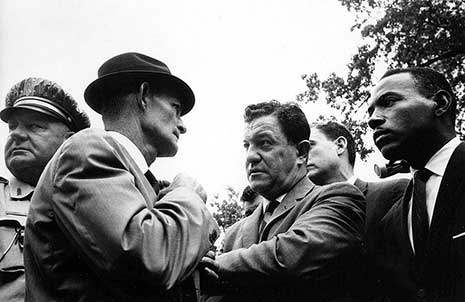September 30, 1962: James Meredith & the University of Mississippi

By Elizabeth Brevard, Intern, Catalog of American Portraits, National Portrait Gallery
By the fall of 1962, racial tension had exploded in the American South. Groups such as the Little Rock Nine and the Freedom Riders had exposed the violence spurred by the deep-seeded stigmas of many Americans and the need for change. James Howard Meredith had intently followed the escalated resistance and believed that it was the right time to move aggressively in what he considered a war against white supremacy.
Meredith was born in Kosciusko, Mississippi, on June 25, 1933. Unlike many African Americans in Mississippi at the time, his father, Moses, was an independent farmer and a registered voter. Moses, who was the son of a slave, fenced off their property and minimized the family’s interaction with outsiders. Meredith first experienced the humiliation of racial discrimination at age fifteen, on a return train to Mississippi after visiting family in the North. He remembered in 1962, “The train wasn’t segregated when we left Detroit, but when we got to Memphis the conductor told my brother and me we had to go to another car. I cried all the way home from Memphis, and in a way I have cried ever since” (Doyle 19).
Meredith enlisted in the armed forces after high school, joining the air force. As the most recently formed branch of military service, the air force lacked a tradition of racism. Over five years, he became known for his meticulous attention to detail and frugality with his work, and in 1956, he received a post in Japan, bringing his new bride, Mary June Wiggins. The racial tolerance that he witnessed in Japan profoundly affected his understanding of self and society.
In 1960, after an honorable discharge, he returned to Mississippi, where he registered for the fall semester at the all-black Jackson State College. He helped create a small campus secret society called the Mississippi Improvement Association of Students, or MIAS. They made leaflets of anti-white supremacy literature and wrote “MIAS vs. BIAS: who are you for?” on blackboards before classes.
The day after John F. Kennedy took office, Meredith began the struggle to attend the all-white University of Mississippi with his mailed request for a brochure and application. The ensuing events instigated a political battle that would lead to the direct involvement of Mississippi Governor Ross Barnett, Attorney General Robert Kennedy, and the president of the United States.
The university rejected his application twice, and it would take a year and a half and the force of the United States Supreme Court for Meredith to be admitted. Still, both times Meredith attempted to register, aided by a squad of U.S. marshals, Governor Barnett presented official proclamations denying his entry to the university.
Hundreds of civilians, many of them armed, began to take action themselves by entering Oxford and the university’s campus in protest. The growing mass of impassioned citizens and unyielding politics compelled President Kennedy to order the preparation of U.S. military force.
On September 30, 1962, a group of marshals, including the deputy attorney general, escorted Meredith to his dormitory. Marshals also stationed themselves at the university’s Lyceum building, which would become the epicenter of their clash with the violent mob armed with guns, Molotov cocktails, and whatever else they could find.
From September 30 to October 2, marshals and the later-arriving Mississippi National Guardsmen and U.S. army soldiers fought against the swarms of citizens. One hundred and sixty-six marshals and forty-eight American soldiers were injured, while two civilians were killed in the melee. About three hundred citizens were taken prisoner by marshals and federal troops. After the riot was crushed, the military continued to occupy Oxford for almost ten months.
James Meredith officially became the first African American student at the University of Mississippi on October 2, 1962. He was guarded twenty-four hours a day by reserve U.S. deputy marshals and army troops, and he endured constant verbal harassment from a minority of students. On August 18, 1963, Meredith fulfilled his childhood dream to graduate from the University of Mississippi with a degree in political science.
Meredith continued his studies, receiving a law degree from Columbia University. In 1966, he started a 213-mile “March Against Fear” from Memphis to Jackson by himself to advocate voting rights. On the second day of the march, Meredith absorbed nearly one hundred pellet wounds when a sniper opened fire. Leaders of major civil rights organizations, including Martin Luther King Jr., invited Americans to join them on the resumed “Meredith March.” Meredith recovered in time to rejoin the march on its entrance into Jackson.
Author William Doyle notes, “The prospect of living out his life in the Dark Age of a segregated Mississippi was simply unacceptable to [Meredith]. . . . As he later explained, ‘I asked myself the question, “Why should it be someone else?” If people keep placing the responsibility with someone else, nothing will ever be accomplished’” (Doyle 32). Meredith remains a crucial figure in the civil rights movement for his commitment and bravery fifty years ago.
Cited:
William Doyle, An American Insurrection: The Battle of Oxford, Mississippi, 1962 (New York: Doubleday, 2001).